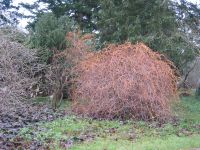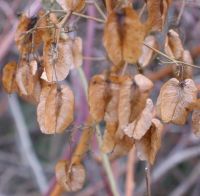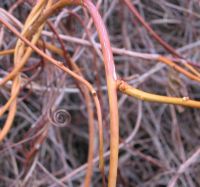Regels three-wing nut, yellow vine - Trypterygium regelii
English name:
Regels three-wing nut, yellow vine
Scientific name:
Trypterygium regelii
Family:
Celastraceae (staff vine family)
Height:
2 M without support
Flowering:
mid July
Range:
China, Korea, Japan
 |
|
 |
 |
The Trypterygium regelii in the pictures is from seed sent to us in 1968 from Dr. Saburo Murai, Tohoku Forest Tree Improvement Station, Japan. The seed was collected in Iwate Prefect on the Island of Honshu. This group of 4 intertwined plants can be found to the right of the main road about 85 m from the main entrance in square 1015 position 2939.
Plant description:
Upon entering the Arboretum on a sunny day in December, (or even on an overcast day) one soon notices the bright yellow and red twigs of this month plant, the yellow vine or Regels three-winged nut, growing to the right of our main road. In flower, it is worth seeing (and smelling) but it was the unusual three winged nuts that first attracted my attention as a newcomer to the Arboretum in Hørsholm. Only recently did I discover that it is not only a handsome garden plant but also a plant with important medicinal properties.
The genus Tripterygium is distributed in China, Japan and Korea. The genus name is derived from the three-winged seed, where tri is 3 and pterygium refers to the wings. The genus has 2 species and we have both (Tripterygium regelii and T. wilfordii) growing at Hørsholm, but only one example of the later species. There are 31 living specimens of T. regelii. All were collected in the wild and 27 of these were collected during the Nordic Arboretum Expeditions to Japan and Korea in 1976. The Tripterygium species are traditional medicine plant in Asia and its usefulness has been confirmed. Much research is being done on its chemistry and medical applications. Like many medicine plants these plants are poisonous and a rood extract has been used as an insecticide. Extracts from the plants are used in treating arthritis, cancer, and there is a report of anti-HIV activity.
Tripterygium regelii was introduced into Arnold Arboretum in 1905 and then to Kew Gardens in London. Apparently it was first mentioned in the Danish literature in 1936. We first received seed of this species in 1960, from the Arboretum in Wageningen, Netherlands.
These are deciduous climbing shrubs about 2 m high when unsupported but climbing much higher into trees. The young bark is yellow to orange turning to red and then grey. Leaves are alternate on the twigs. They are oval to ovate with a serrated edge and tapered at the tip to a point. Flowers are 5-6 mm across, greenish-white and are assembled in large inflorescences. There are 5 sepals and 5 petals and the 5 stamens occur on the margins of a cup-shaped disk. The ovary sits on this disk and is three lobed with a short style at the apex. The fruit is a 3 winged nut and light green in colour until they eventually turn brown. The papery wings are heart shaped at the base.
Tripterygium regelii is a vigorous climbing shrub in Denmark with colourful twigs to brighten up dreary winter days. The branches are bent and grow to reach the ground or climb in neighbouring plants. It has been recommended as a potential ground cover plant. Perhaps it is not as handsome as T. wilfordii as the later has fruit of a striking bronzy red colour, but this species is much hardier. It may be possible to also see this plant elsewhere since arboretum in Hørsholm has sent living specimens for trial at: Århus Botanic Garden and Copenhagen Botanic Garden, and Arne Vagn Jakobsens Nursery in Glamsbjerg.
References:
Bean, W.J. 1980 Trees and Shrubs Hardy in the British Isles Vol IV Ri-Z Eight edition. John Murray publishers. 808 pp.
Lange, J. 1999. Kulturplanternes Indførselshistorie i Danmark indtil midten af 1900-talet. (Introduction History of Cultivated Plants in Denmark up to the middle of the 20th century). DSR Forlag, Frederiksberg C. 458 pp.
Mabberley, D.J. 1998. The Plant Book. The Bath Press, Bath, 858 pp.
Olsen, O. et al. 1997 Havens Planteleksikon. Træer og Buske. (Danish Plant Encyclopedia, Trees & Bushes). Det Danske Haveselskab Publisher, 674 pp.
Rehder, A. 1940. Manual of Cultivated Trees and Shrubs Hardy in North America 2nd edition. The Macmillan Co. New York.
Jensen, N. 1994. Guide til Arboretet i Hørsholm (Guide to the Arboretum Hoersholm, Denmark), Dansk Dendrologisk Årsskrift 12: 1-238.
Flower photos: Plantentuin Esveld; http://www.esveld.nl/htmldia/t/trrege.htm
